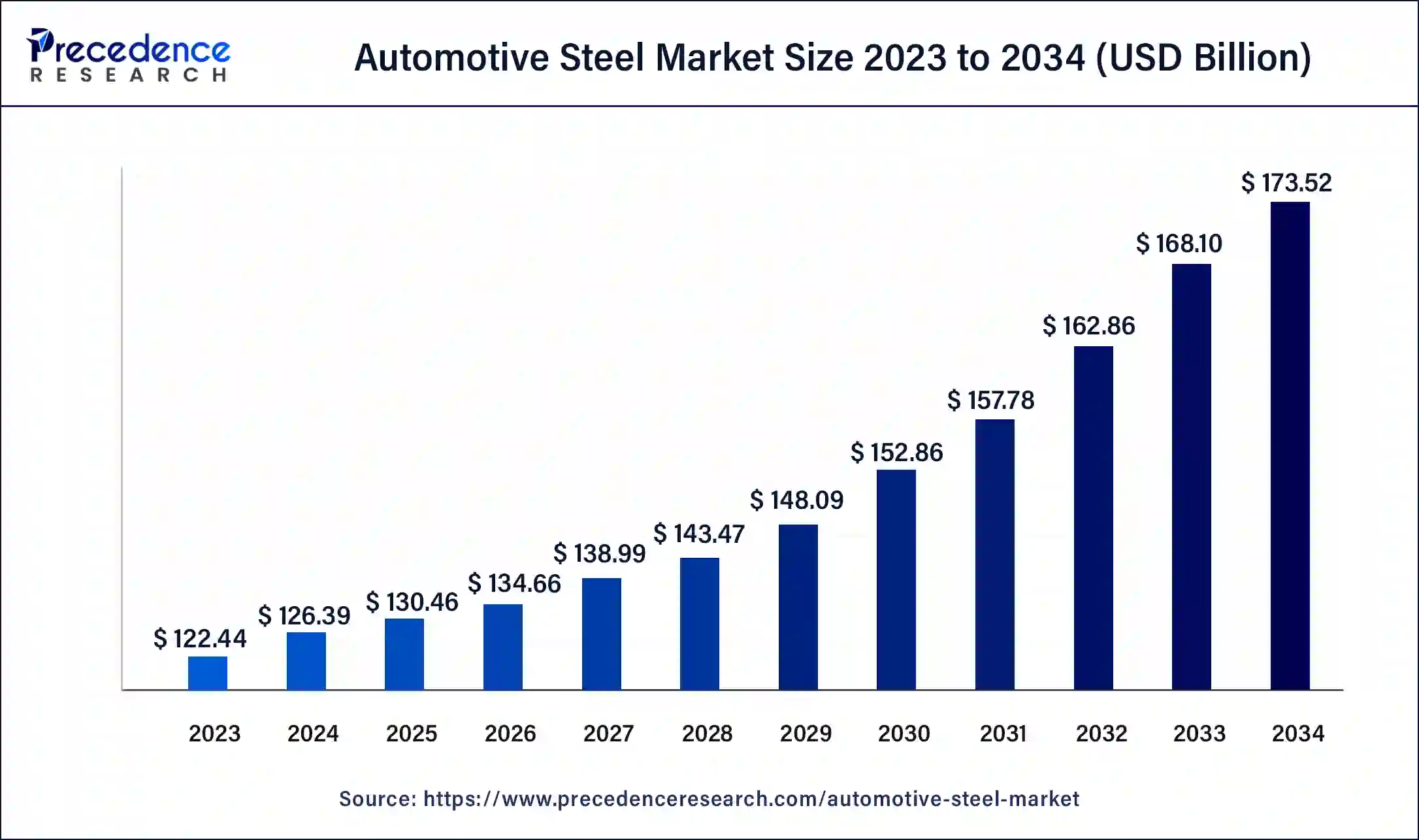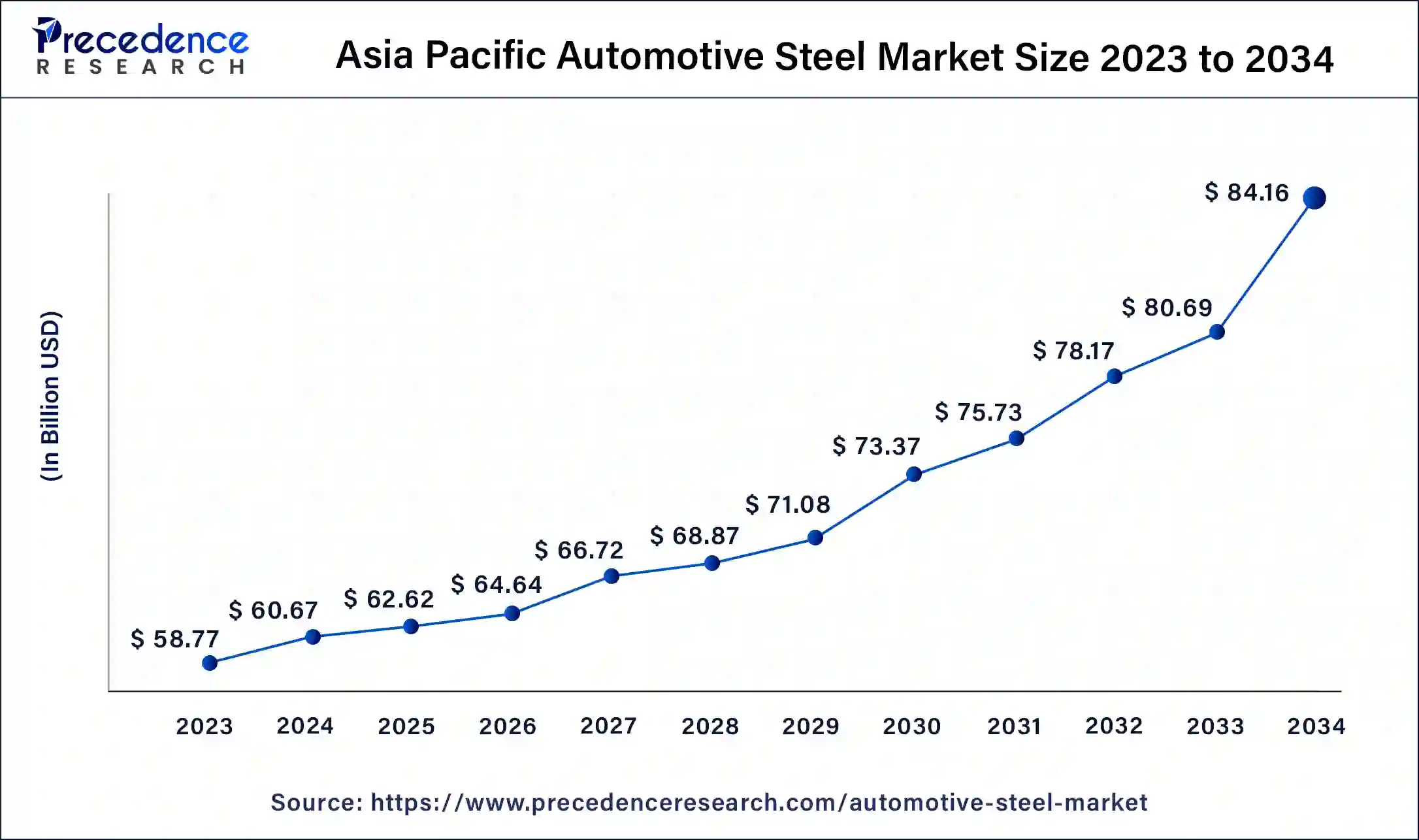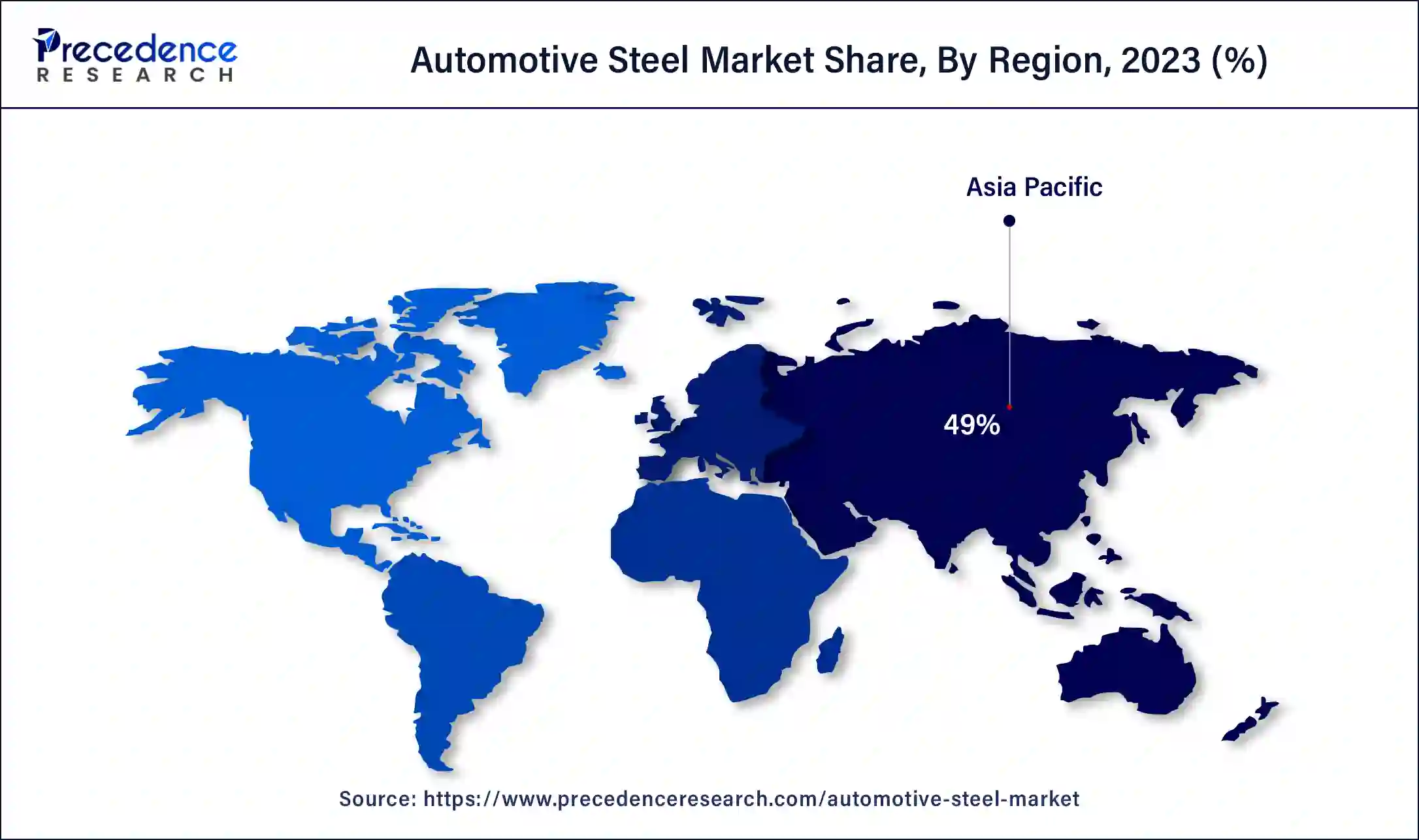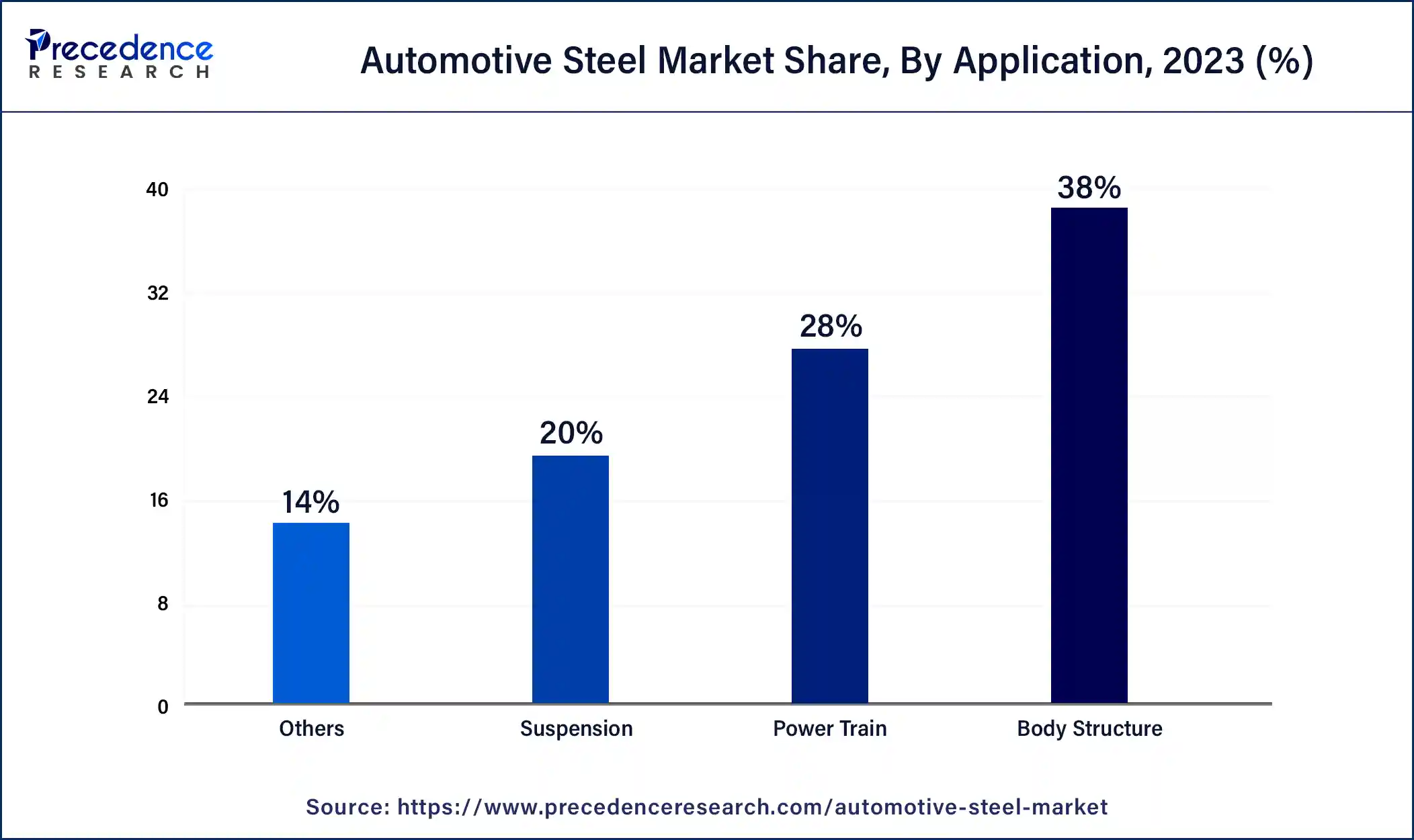List of Contents
Automotive Steel Market Size and Forecast 2025 to 2034
The global automotive steel market size is projected to be worth around USD 173.52 billion by 2034 from USD 126.39 billion in 2024, at a CAGR of 3.22% from 2025 to 2034. Since automotive steel is a key component used in the construction of car bodywork and other parts, the demand for it is increased by the ongoing increase in demand of the automotive steel market worldwide.

Automotive Steel Market Key Takeaway
- In terms of revenue, the automotive steel market is valued at $130.46 billion in 2025.
- It is projected to reach $173.52 billion by 2034.
- The automotive steel market is expected to grow at a CAGR of 3.22% from 2025 to 2034.
- Asia Pacific led the automotive steel market with the highest market share of 49% of market share in 2024.
- North America is expected to grow at a CAGR of 3.14% during the forecast period.
- By vehicle type, the passenger vehicle segment contributed the largest market share of 74% of market share in 2024.
- By vehicle type, the light commercial vehicles segment is expected to grow at the fastest rate in the market during the forecast period.
- By application, the body structure segment generated the biggest market share of 38% in 2024.
- By application, the suspension segment is projected to grow at a notable CAGR of 3.12% during the forecast period.
How Artificial Intelligence is Transforming the Automotive Metal Market
The adoption of artificial intelligence by steel industries is helping optimize operations, and improving safety with a reduction in overall costs. The application of AI by steel companies helps to improve product quality by automating the identification and classification of defects. AI also assists with predictive maintenance of steel products and ensures high quality control standards, contributing to the optimization of performance parameters.
A smart sensor is used to collect data from each stage of production; from raw materials to the finished product. AI algorithms analyze this data to improve quality and efficiency in the quality control of products. AI algorithms can also identify possible operational issues in the early stages and recommend solutions to resolve them with precision and accuracy. Implementation of robotics in the steel manufacturing process helps by reducing the load of dangerous, complicated tasks to be performed, improving safety of workers and minimizing waste by providing energy-efficient production solutions.
- In June 2024, Tate Steel Nederland announced the launch of an innovative, precisely designed recycled steel product named Zeremis Recycled available to the consumers from automotive, construction, and packaging industries. It has addressed the carbon emission challenges and focused on adopting a decarbonization approach making the environment greener, cleaner, and safer.
Asia Pacific Automotive Steel Market Size and Growth 2025 to 2034
The Asia Pacific automotive steel market size was exhibited at USD 60.67 billion in 2024 and is projected to be worth around USD 84.16 billion by 2034, poised to grow at a CAGR of 3.33% from 2025 to 2034.

Asia Pacific held the largest share of the automotive steel market. Asia Pacific is a major hub for the automotive industry, especially for nations like China, India, Japan, and South Korea. The need for automotive steel is driven by the rise in car production. The market is being helped by innovations in steel production, such as ultra-high-strength steels (UHSS) and advanced high-strength steels (AHSS). These materials provide better safety and fuel economy, which are essential for contemporary automobiles. Strong laws governing safety requirements and car emissions are pressuring producers to use premium steel. The dynamics of the steel market may be impacted by governments in the region's promotion of electric vehicles (EVs). The region's growing economies are becoming more urbanized, and there are higher rates of vehicle ownership, which is fueling demand for automotive steel.
Due to an increase in demand for lightweight fuel-efficient vehicles, growing emission regulations, Europe is the second fastest-growing region in the Automotive Steel market. The evolving landscape of automotive manufacturers, combined with technological improvements in high-strength steel production, will bolster market expansion in the region. The European steel industry, with approximately 500 production sites across 22 Member States, contributes around €80 billion to the EU's GDP and supports over 2.6 million jobs. Additionally, investments in electric vehicle support infrastructure and a commitment to sustainability and green manufacturing will enhance further opportunities for the growth of specialized steel components in the region.

North America is expected to host the fastest-growing automotive steel market during the forecast period. Automakers are using ultra-high-strength steels and advanced high-strength steels to reduce vehicle weight without compromising safety as a result of the drive for fuel economy and pollution reduction. The demand for lightweight, high-performance materials is expected to fuel expansion in the North American automotive steel industry. Strong industry alliances and developments in steel technology are anticipated to support the market's growth even as it faces obstacles from substitute materials and fluctuations in the price of raw materials. The pricing volatility of raw materials such as coking coal and iron ore can affect the profitability and cost structure of steel manufacturers. Automakers and steel producers are collaborating to provide customized steel solutions that satisfy regulatory and performance criteria.
- In March 2025, Gov. Landry joined President Trump at the White House to announce plans for a USD 5.8 billion Hyundai steel mill in Louisiana as part of a USD 20 billion investment in the U.S. The project is expected to create 1,300 direct jobs with an average salary of USD 95,000 and approximately 4,100 indirect jobs, resulting in a total of 5,400 new jobs. Hyundai Steel Company President and CEO Gang Hyun Seo stated, “We plan to supply automotive steel plates not only for Hyundai Motor and Kia's strategic models but also to expand sales to U.S. automakers in the future.”
Market Overview
The growing demand for automobiles globally, particularly in emerging nations, has been driving the automotive steel market, which has been expanding steadily. The development of high-strength steel variations and technological breakthroughs are also driving market growth. Automobile production is increasing, especially in China and India, which drives up demand for automotive steel. Automakers are being compelled by strict emission laws enforced by governments across the globe to employ lightweight materials like high-strength steel in order to improve fuel efficiency. Advanced high-strength steels (AHSS) must be used in vehicles in order to increase safety standards and comply with crash test rules without increasing weight.
Because of its exceptional strength-to-weight ratio, which contributes to lighter vehicles and increased fuel efficiency, AHSS is becoming more and more popular. Because of UHSS's extraordinary strength, which improves car safety characteristics, it is also being utilized. As the market for electric vehicles (EVs) expands, certain steel grades that are both lightweight and battery pack-compatible are being developed. A threat to the steel market comes from the car industry's investigation of lightweight substitutes for steel, including aluminum, magnesium, and composite materials. Steel producers must continually innovate and adapt to advances in material science and manufacturing techniques. The automotive steel market is anticipated to keep expanding as steel technology advances and consumer demand for safer, more fuel-efficient cars rises.
Automotive Steel Market Growth Factors
- The automotive steel market demand is expanding due to the growing global car market, especially in emerging economies. Increased output volumes demand greater raw resources, including steel.
- Vehicle performance and safety have increased thanks to the development of advanced high-strength steel (AHSS). Automakers seeking to increase safety standards and fuel efficiency find AHSS appealing since it enables the design of lighter, stronger, and safer vehicles.
- Worldwide, governments are enforcing more stringent regulations pertaining to fuel efficiency and emissions. This forces automakers to employ lightweight materials—like high-strength steel—in order to lighten vehicles and increase fuel economy without sacrificing security.
- The need for particular kinds of steel, which are utilized in EV battery packs and structural components, is being driven by the growing production and use of electric vehicles. High-strength, lightweight steel is necessary to maximize EV performance and safety.
- The creation of new steel grades and more effective production methods are examples of innovations in the steel manufacturing process that are lowering prices and improving the qualities of automotive steel, increasing its appeal to manufacturers.
- The automotive steel market is being positively impacted by the growing popularity of sport utility vehicles (SUVs) and crossovers, which typically require more steel due to their greater size and higher safety regulations.
- Building more infrastructure, especially in emerging nations, helps the automobile sector flourish, which in turn raises the need for automotive steel.
- Consumer spending power rises as a result of economic development in areas like the Asia Pacific, Latin America, and some sections of Africa. This boosts car sales, which in turn raises the demand for the automotive steel market.
- Due to its high recyclable content, steel is becoming more and more popular in the automotive industry. Steel's continuous usage in the production of automobiles is supported by its effective recycling.
Market Scope
| Report Coverage | Details |
| Market Size by 2034 | USD 173.52 Billion |
| Market Size in 2025 | USD 130.46 Billion |
| Market Size in 2024 | USD 126.39 Billion |
| Market Growth Rate from 2025 to 2034 | CAGR of 3.22% |
| Largest Market | Asia Pacific |
| Base Year | 2024 |
| Forecast Period | 2025 to 2034 |
| Segments Covered | Vehicle Type, Application, and Regions |
| Regions Covered | North America, Europe, Asia-Pacific, Latin America and Middle East & Africa |
Market Dynamics
Driver
Rising demand for lightweight vehicles
To fight climate change, governments all around the world are enforcing strict emissions rules. Lightweight automobiles help manufacturers meet these rules by reducing greenhouse gas emissions. Advanced high-strength steel technology has allowed for the production of lighter cars without sacrificing durability or safety. Because it reduces weight and has greater strength, AHSS is a material of choice for automakers. In general, lighter cars have superior handling and performance qualities. The need for lightweight automotive solutions is being driven by consumers who are looking for high-performance vehicles. In line with global sustainability aspirations, the automotive steel market is also investing in sustainable manufacturing techniques to lessen the environmental impact of steel production.
Restraint
Raw material price volatility
One of the main basic materials used to make steel is iron ore. The mechanics of global supply and demand, geopolitical unrest, and the state of the economy of major producing nations like Australia and Brazil all affect its prices. Energy-intensive steel production uses a lot of fuel and power. Volatility in steel pricing can be caused by changes in energy prices, which are frequently impacted by geopolitical issues and market speculation. The price of imported raw materials from other nations is impacted by exchange rate fluctuations in the automotive steel market. Imports of raw materials can be more expensive or less expensive depending on how strong the local currency is. Natural disasters, logistical difficulties, and political unrest are examples of events that might interrupt the supply chain and result in shortages of raw materials and price increases.
Opportunity
Global market expansion
Determine which areas are seeing an increase in steel usage and automobile production. The three main automotive steel markets are Asia Pacific, Europe, and North America, each with unique regulatory frameworks and preferences. Verify adherence to regional environmental and vehicle safety norms. This includes regulations pertaining to vehicle safety and emissions that influence material selections. Keep abreast of developments in automotive steel, including ultra-high-strength steels (UHSS) and advanced high-strength steels. These materials help achieve fuel efficiency targets by improving vehicle safety and light-weighting. Establish collaborations with suppliers, research centers, and automakers to jointly create solutions suited to local needs. Partnerships can hasten product uptake and market entry.
Vehicle Type Insights
The passenger vehicle segment held the largest share of the automotive steel market in 2024. Since it accounts for a sizable amount of the steel demand in the automobile industry, the passenger car segment is important to the market. Steel is a common material used in passenger cars because of its strength, low cost, and capacity to take on intricate designs. Steel is utilized in automobile applications for safety features, including door beams and seat frames, as well as body panels, chassis, and structural elements. Regulations pertaining to vehicle safety and emissions, vehicle production trends, and technological developments in steel manufacture all have an impact on the demand for automotive steel in the passenger car market.
The light commercial vehicles segment is expected to grow at the fastest rate in the automotive steel market during the forecast period. Particularly in Asia Pacific, light commercial vehicles (LCVs) are important to the automotive steel industry. These commercially used light trucks, vans, and pickups are among the vehicles that primarily depend on steel for their durability, safety features, and structural integrity.
LCVs are a significant market segment in the automotive steel industry that drives demand for several steel grades, including advanced high-strength and high-strength steels (AHSS). Manufacturers emphasize steel's capacity to improve fuel economy and lower emissions while also offering advantages for safety and lightweighting. Steel continues to be essential to maintaining commercial vehicle performance and safety standards, as seen by the expansion of the LCV market in Asia Pacific.
Application Insights
The body structure segment held the largest share of the automotive steel market in 2024. For current car bodywork to have the intricate shapes and designs they demand, automotive steels must have a high degree of formability. Achieving both aerodynamic efficiency and aesthetic appeal requires doing this. The steel used for car bodies needs to be sufficiently resistant to corrosion, especially in areas where rust and environmental deterioration are common.
Steel has always been heavier than substitute materials like aluminum or composites, but improvements in AHSS and novel processing methods enable substantial weight savings without sacrificing strength or safety. For instance, the strong automobile industry in Asia Pacific and the need for lightweight, high-strength materials to meet emissions regulations and increase fuel efficiency are driving forces behind the region's automotive steel market.

The suspension segment is expected to grow at the fastest rate in the automotive steel market during the forecast period. In the automotive steel market, suspensions are essential because they support and maintain structural integrity for car components. High-strength steel alloys are frequently used in automotive suspensions because of their exceptional strength, durability, and weight balancing. These components are essential for making sure cars can manage a range of road conditions and still give passengers stability and comfort. The goal of recent developments in automotive steel technology has been to reduce weight and increase strength, which has improved vehicle performance and fuel economy. With new materials and production techniques, this market is still developing while adhering to strict environmental and safety regulations.
Automotive Steel Market Companies
- ArcelorMittal
- Thyssenkrupp
- Nippon Steel
- Hyundai Steel
- POSCO
- United States Steel
- JFE Holdings
- Nucor Corp.
- HBIS
- Baowu
- China Steel Corporation
Recent Developments
- In January 2025, ArcelorMittal Nippon Steel India (AM/NS India), a prominent joint venture between global steel titans ArcelorMittal and Nippon Steel, launched advanced automotive steel production lines 2025. Dilip Oommen, CEO of AM/NS India, stated, "These two units mark a significant step toward our goal of delivering high-quality, tailored steel solutions for the automotive sector, strengthening India's steel ecosystem and reinforcing the ‘Atmanirbhar Bharat' vision." Source: knnindia.co.in
- In October 2024, Flowmaster, part of the Holley Performance Brands portfolio, announced the launch of the Flowmaster Signature Series, the brand's new premium exhaust line. Engineered for increased power and performance, the next-generation exhaust system provides a finely tuned sound and features brushed stainless steel for a clean, high-end look that resists premature rusting. Source: businesswire.com
- In September 2024, GM, Hyundai signed a strategic agreement to explore future collaborations. The partnership aims to leverage the strengths of both companies to enhance efficiency, reduce costs, and accelerate the development of a broader range of vehicles and technologies. Additionally, GM and Hyundai will explore joint sourcing opportunities for critical materials like battery raw materials and steel. Source: mobilityoutlook.com
- In April 2024, The Treo Plus with a metal body is the newest electric vehicle from Mahindra Last Mile Mobility Limited (MLMML), the top-ranked electric 3-wheeler manufacturer in India. In response to consumer input, MLMML gave its immensely popular Treo Plus product a metal body. Mahindra has arranged a number of discounts with its financing partners in order to make the new Treo Plus more accessible to consumers.
- In January 2024, as of the last quarter of 2023, BYD sold more battery-powered vehicles than Tesla, making it the largest EV manufacturer in the world. However, China accounted for the majority of BYD's top-performing sales. That might alter now that the company, backed by Warren Buffett, is attempting to enter Southeast Asian, Latin American, and European markets.
Segment Covered in the Report
By Vehicle Type
- Passenger Vehicles
- Light Commercial Vehicles
- Heavy Commercial Vehicles
By Application
- Body Structure
- Power Train
- Suspension
- Others
By Geography
- North America
- Asia Pacific
- Europe
- Latin America
- Middle East & Africa
For inquiries regarding discounts, bulk purchases, or customization requests, please contact us at sales@precedenceresearch.com
Frequently Asked Questions
Ask For Sample
No cookie-cutter, only authentic analysis – take the 1st step to become a Precedence Research client